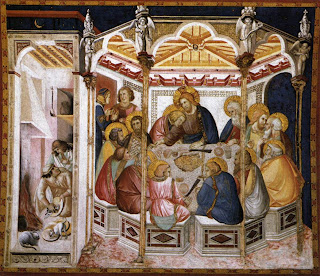Tuesday, July 14th, 2009
Pietro Lorenzetti’s Kitchen Scene
 Pietro Lorenzetti, The Last Supper, c. 1315-19
Pietro Lorenzetti, The Last Supper, c. 1315-19
I realize that this may be true. This may be just a domestic scene. However, this scene made me think of the biblical story of the woman of Canaan, who asks Jesus to bless her daughter. Since this woman was a Gentile, Jesus answered that he couldn’t extend a blessing and metaphorically “cast it to dogs” (Matthew 15:26), because Christ’s mission was to the house of Israel. This woman persists in asking for a blessing, and tells Jesus that “the dogs eat the crumbs which fall from their master’s table.” (Matthew 15:27). Would the 14th century Italians (i.e. Gentiles) have been interested in this story? I imagine that they would have viewed themselves as the Gentiles who were beneficiaries of Christ’s sacrifice (as symbolized in the sacrament of the Last Supper). I wonder if Lorenzetti’s kitchen scene and depiction of the dog eating scraps could allude to this passage.
Any thoughts?
1 Emma Barker, Nick Webb, and Kim Woods, eds., The Changing Status of the Artist, (London: Yale University Press, 1999), 52.
I think that's a beautiful metaphor. I like your thoughts on this and can see why they would include the scrapping/dog crumb scenes. It's really quite beautiful to see that people would be moved to add such things.
I did think of you when I was at the Art Gallery a few days back! Have you ever noticed how WEIRD some paintings of Christ get the further in time you go back? I mean, wow, some of those baby Jesus' are freaky.